Pompeii vs. Herculaneum: Which Should You Visit?
If you love history and you’re planning a trip to Italy, chances are you’re wondering if you should visit Pompeii, Herculaneum, or both! Before visiting these unforgettable ancient Roman cities, I found myself wishing there had been one clear, easy comparison to help me decide how to plan, that wasn’t too vague, or too complicated.
That’s exactly why I created this guide – to give practical, firsthand advice from someone who had been dreaming of exploring these ancient Roman ruins since I was a little kid.
It will answer questions like how much time you need, what you’ll see, how to get around, pro tips to get the most out of the trip, and what makes each site unique. There are even a couple suggested itineraries and guided tours. By the end, you’ll know exactly which ancient city (or both) is right for your trip, and what not to miss!
The Adventure Lion contains affiliate links and is a member of the Amazon Services LLC Associates Program. If you make a purchase using one of these Amazon links, we receive compensation at no extra cost to you.
Pompeii and Herculaneum – Time Capsules from Ancient Rome
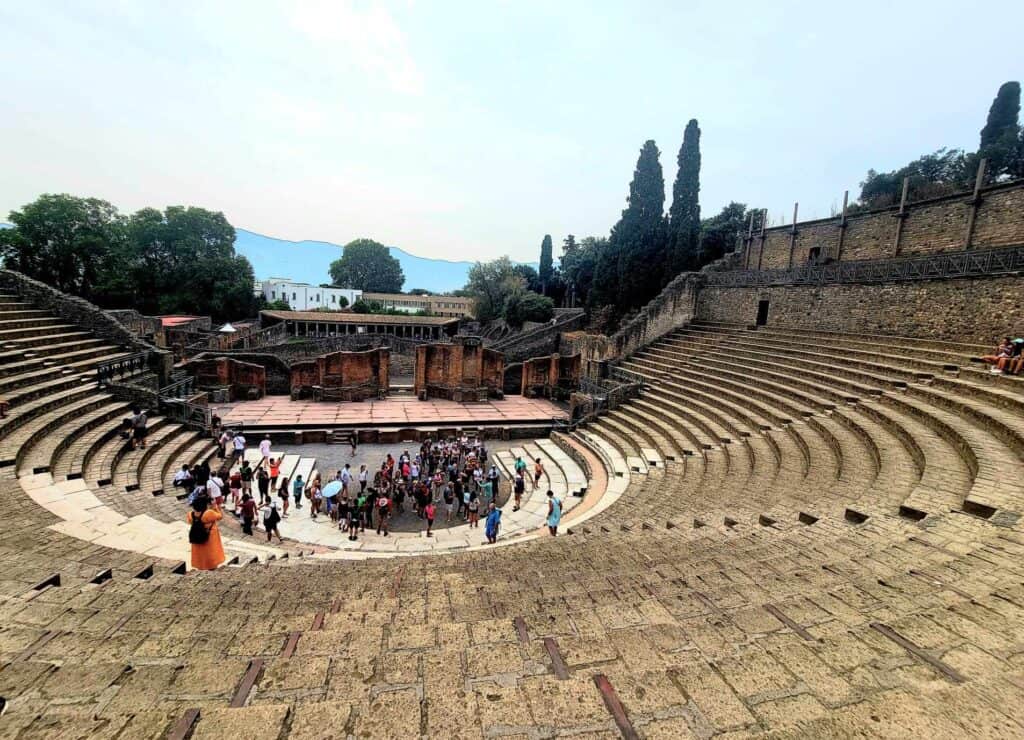
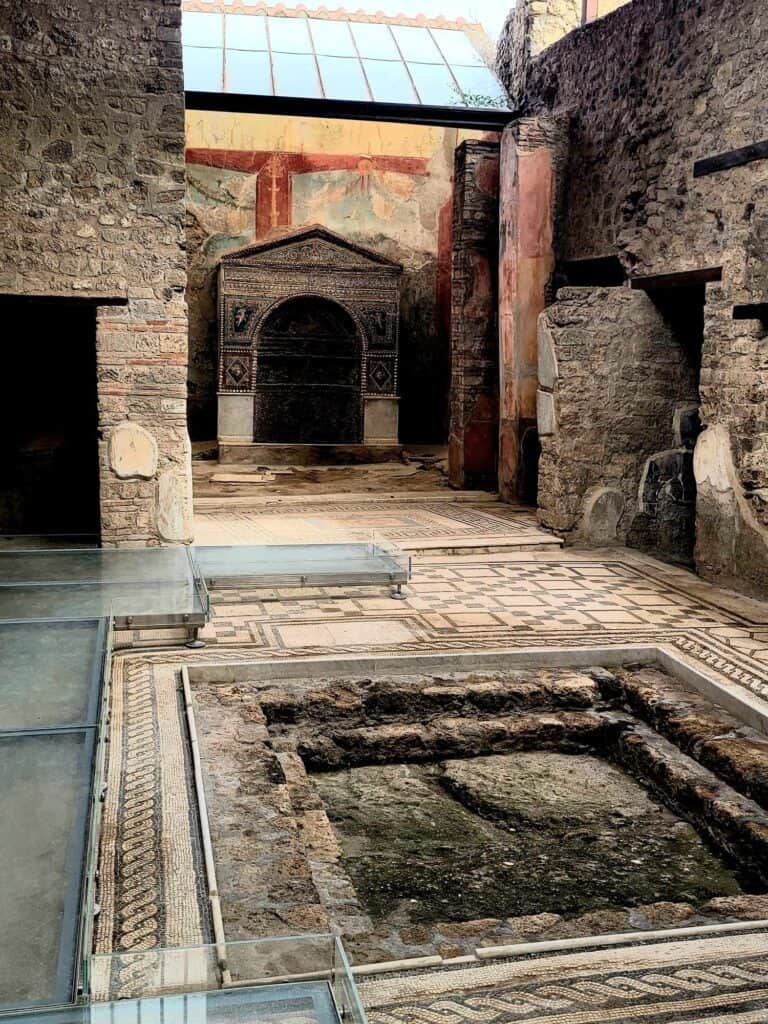

Both Pompeii and Herculaneum were thriving Roman cities that met a tragic end in 79 AD when Mount Vesuvius erupted, spewing rock, hot ash, mud, and poison gas that annihilated the towns below. But what you need to know when deciding which to visit is how differently the two sites were destroyed and preserved.
- Pompeii – the much larger of the two cities was buried slowly as volcanic ash and pumice rained down from the sky, collapsing roofs and burying everything.
- Herculaneum – a wealthier and smaller town on the coast nearby – was hit by a superheated pyroclastic flow, which actually preserved organic material like wood, food, and even the famous Herculaneum scrolls under a 60-foot layer of volcanic mud.
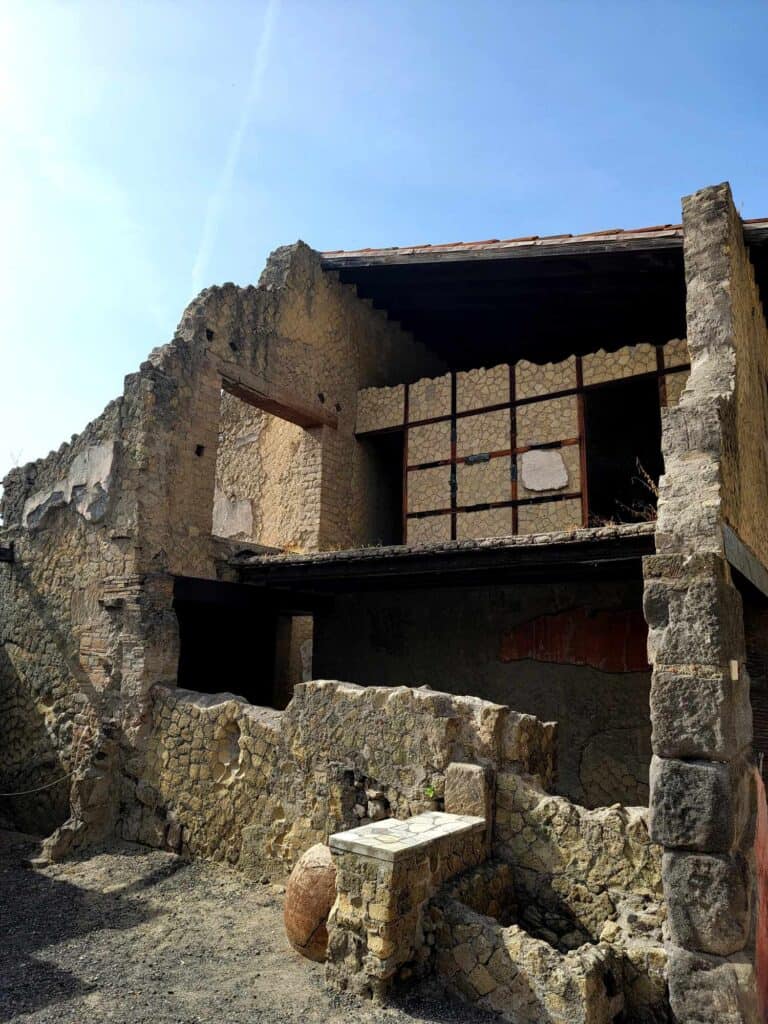
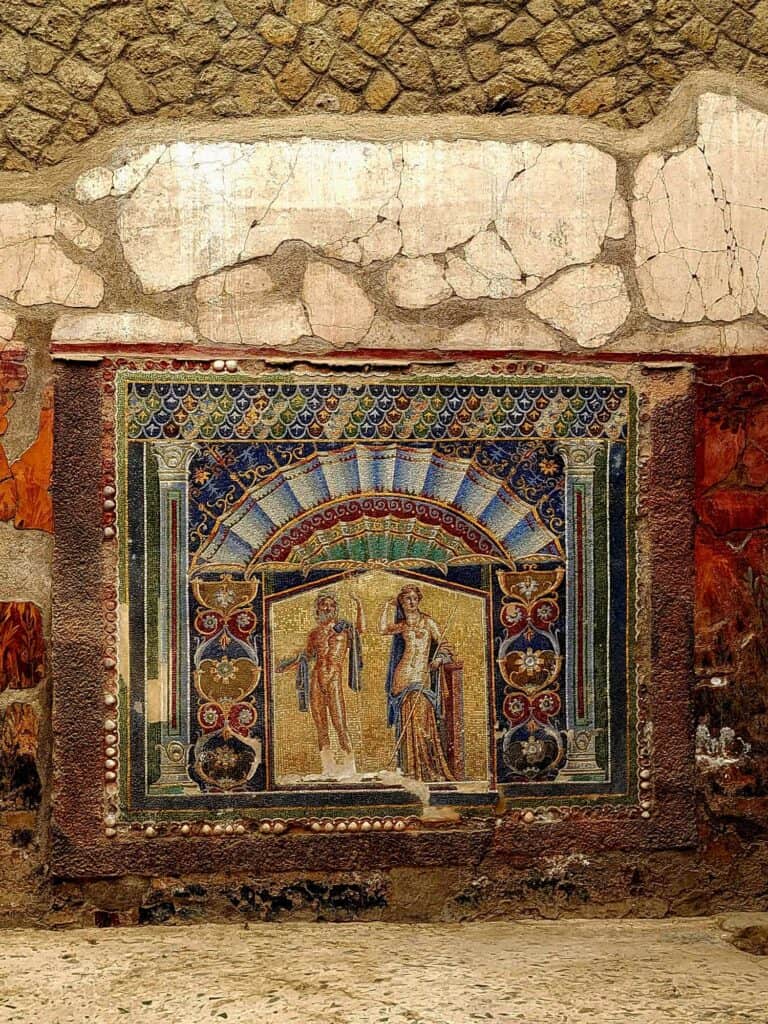
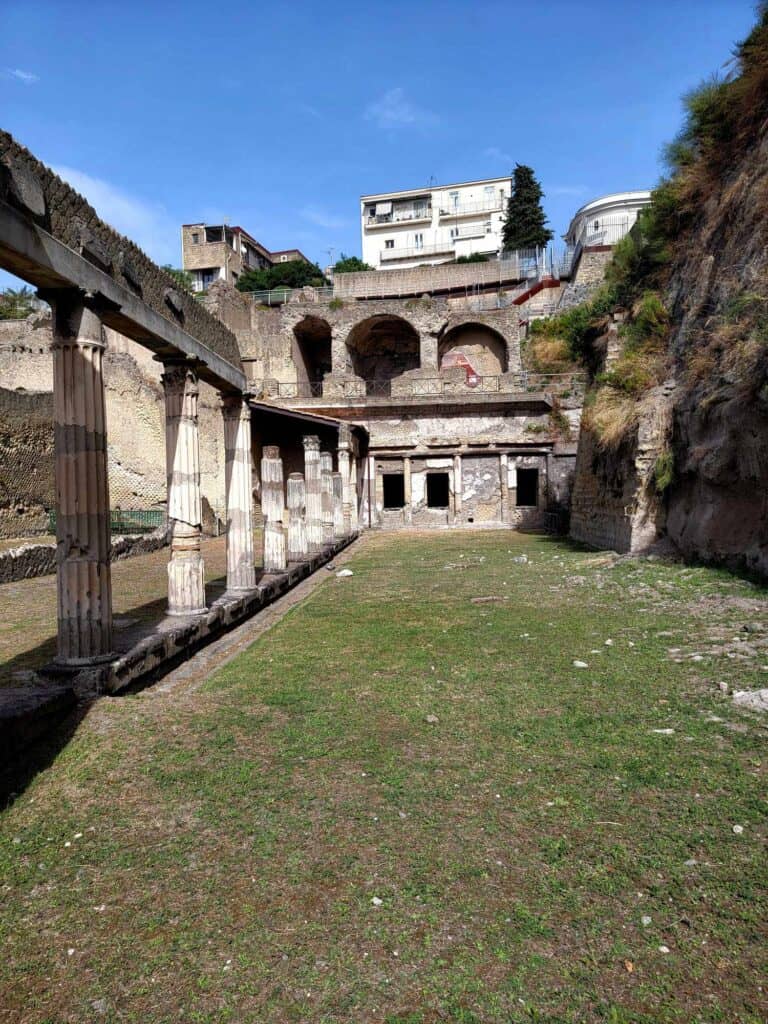
These two terrible circumstances created two very different archaeological experiences. Pompeii is huge, with large iconic features and buildings, and of course it’s the most famous of the two. Herculaneum is smaller, quieter, but better-preserved. Both are UNESCO World Heritage Sites, but they offer different types of insight into life in 79AD.
So when comparing Pompeii vs. Herculaneum, you’re not just choosing between two ruins, you’re choosing between two experiences of ancient Roman life – one grand, one intimate.
🚆 Location, Access & Logistics
Both sites are easy to reach from Naples, Sorrento, or the Amalfi Coast by car, and they’re only about 20 minutes apart by train. You can visit both in a day, but only if you plan carefully, you’re okay with not seeing everything, and you don’t mind a long day of walking.
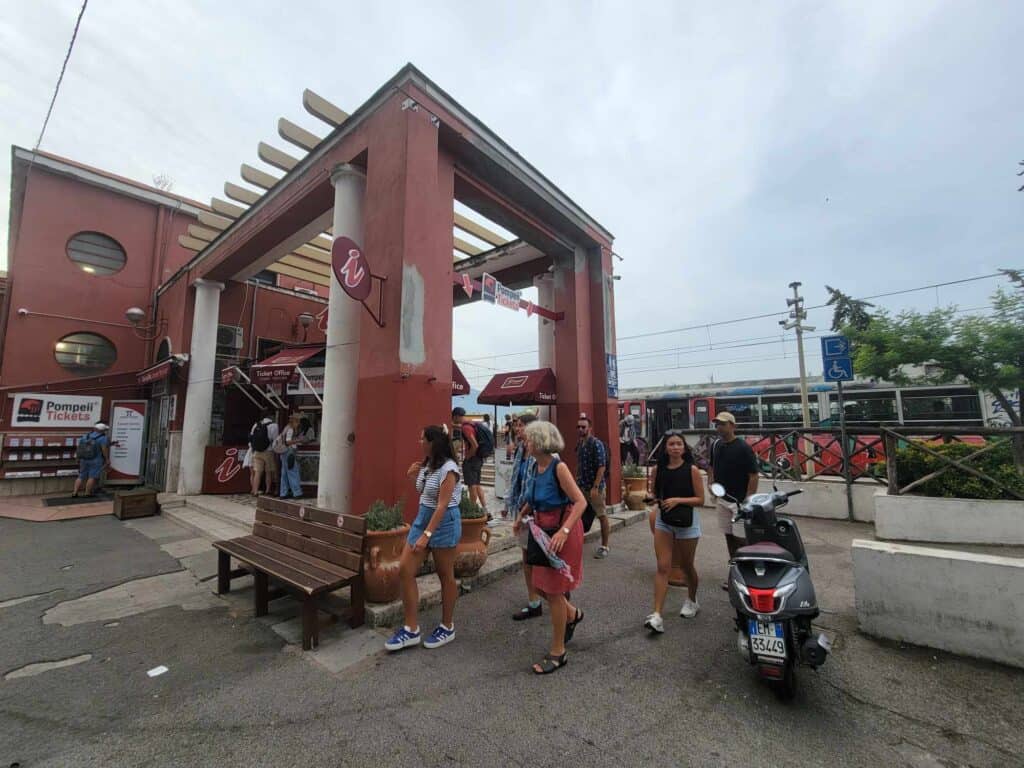
- Pompeii sits right next to the Pompei Scavi – Villa dei Misteri stop on the Circumvesuviana line between Naples and Sorrento. The stop is literally directly in front of the entrance to the park.
- Herculaneum (Ercolano Scavi) is also on the Circumvesuviana line, just 15–20 minutes from Naples, and the park is a 15-20 minute walk from the train station.
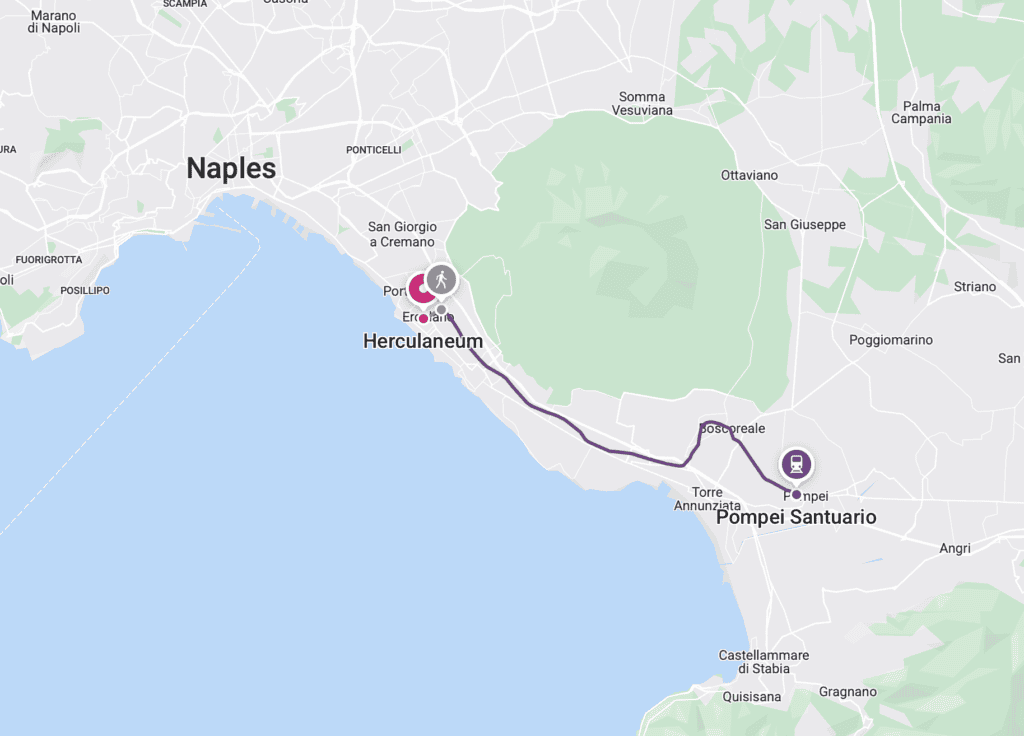
Use this website to enter your location and destination for all the options of how to get to Pompeii and Herculaneum from your hotel.
Parking is available at both locations right at the entrances, but it’s a little tighter at Herculaneum.
Guided tours to the sites leave from Naples, Sorrento and other points on the Amalfi Coast, and even Rome, and can include both sites, or one of them plus Mount Vesuvius.
⏱️ Time Needed to Visit Pompeii vs. Herculaneum
This is one of the biggest differences between Pompeii and Herculaneum, and it’s critical to planning your trip.
🏛️ Pompeii:
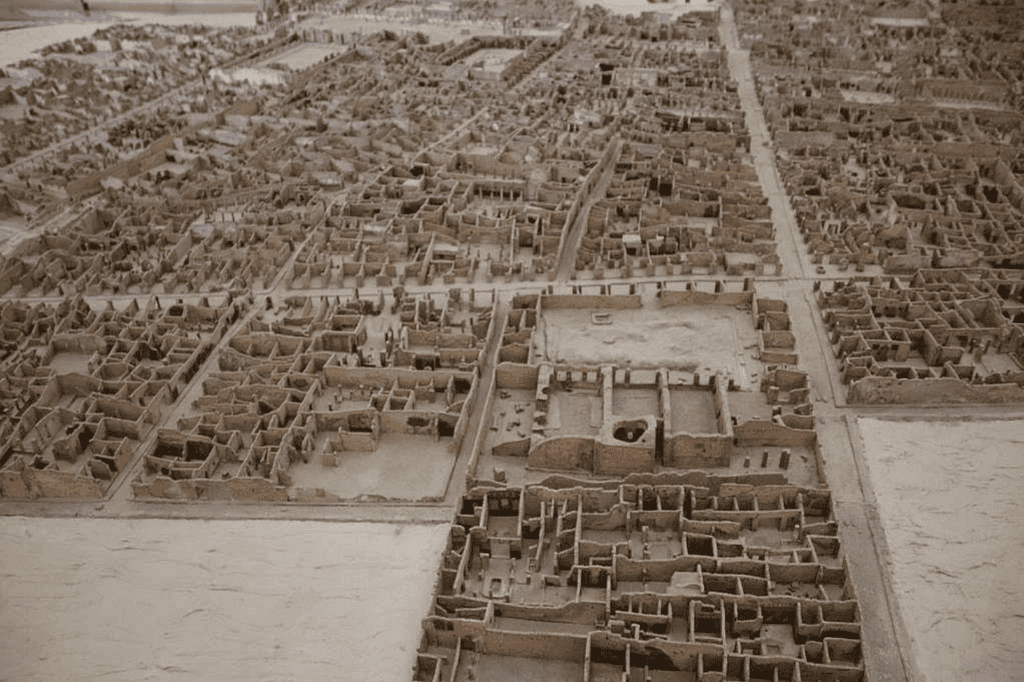
- Plan for at least 3–4 hours, and that’s if you’re moving steadily.
- It’s a very large site, much larger than I ever imagined, covering over 160 acres, with long walking distances and tons of paths.
- You could easily spend a full day in Pompeii and not see everything.
🏠 Herculaneum:
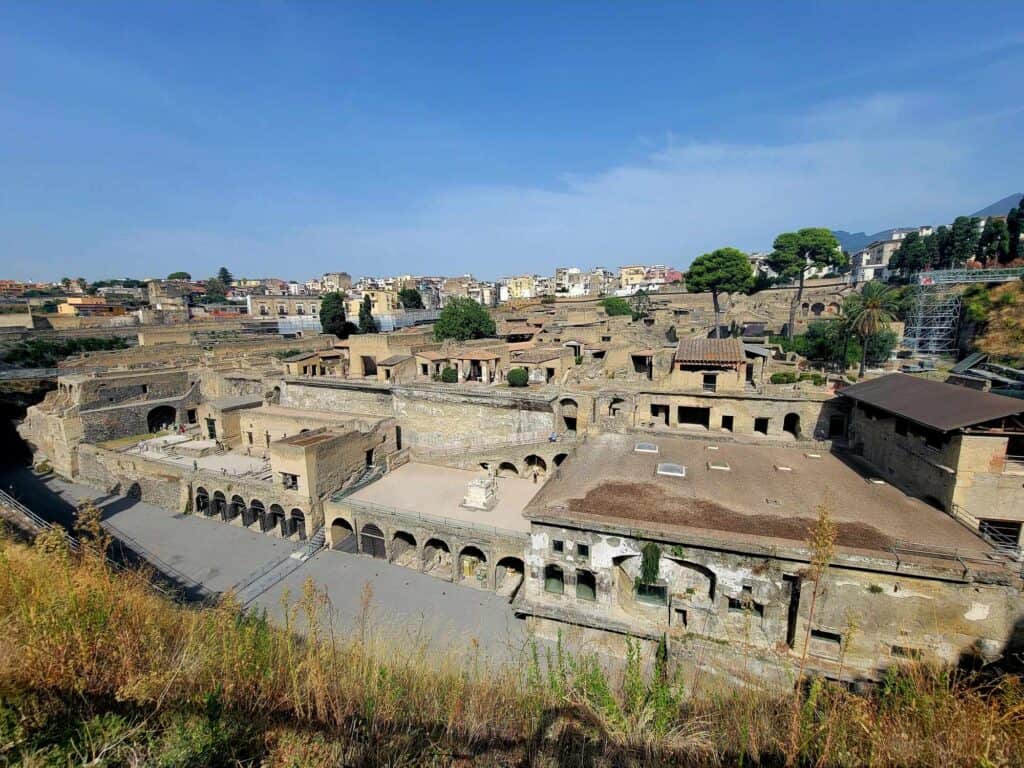
- A much more compact experience where most people spend 1.5 to 2 hours.
- The detail is incredible, so you can really soak in the preservation without rushing.
- Easier to explore thoroughly, especially if you’re short on time, or have less energy for walking.
💡 Pro tip: If you’re tight on time, traveling with kids, or have some mobility or stamina issues, Herculaneum is the better choice. But if you’re an ancient history enthusiast, have time to dedicate, and want to immerse yourself fully, Pompeii is incredible.
🌞 Shade, Temperature & Time of Year
You may not be thinking of this until you’re baking in the midday sun with no escape, and then it’s all you’ll be thinking about. The experience of visiting either site changes dramatically depending on the season and the time of day.
☀️ Pompeii:
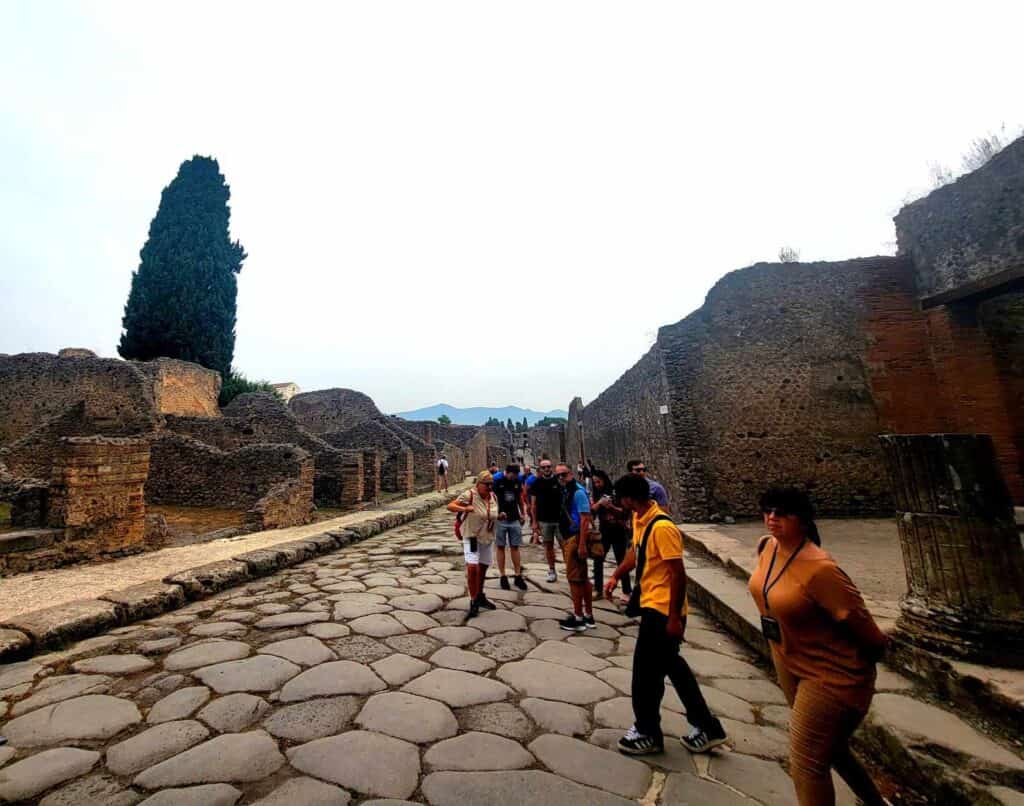
- Almost no shade. Many roofs are gone, and you’re completely exposed nearly the entire time. On a cloudless day it can be a LOT.
- Summer temps can hit 90–100°F (32–38°C) and the stone, which is everywhere, reflects the heat. You must take real precautions to avoid heat exhaustion.
- Best time to visit: October–April, or early morning if in summer.
- Worst time: Midday in July or August — unless you are a desert creature.
🌴 Herculaneum:
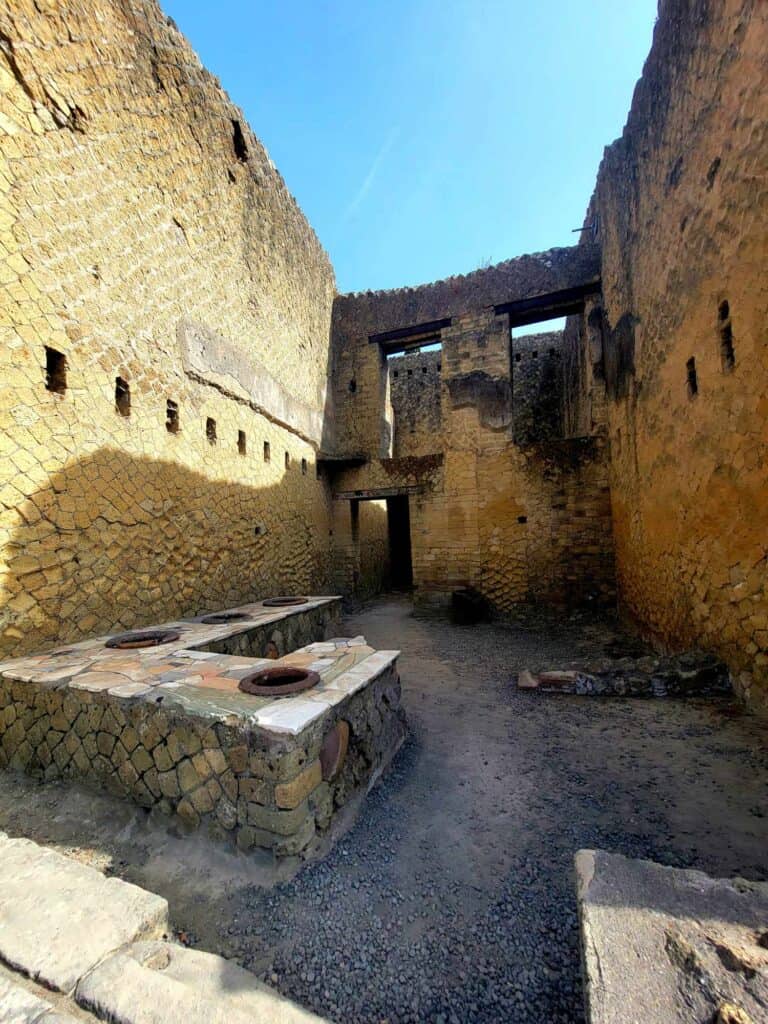
- Much more shade thanks to better-preserved buildings that have overhangs, taller walls, and roofs.
- A little closer to the water and sea breezes.
- Feels more bearable even on hot days — a smart choice if you’re visiting in summer.
💡 Pro Tips:
If you’re visiting in peak season and can only choose one, Herculaneum is far more forgiving on a hot afternoon.
If you do go to Pompeii, you can get some relief in Zone 1 and 2 where there are a few trees and shady spots, and there are also several villas restored with roofs that can provide some temporary relief.
🪨 Pompeii vs. Herculaneum –Terrain, Steps & Accessibility
Both sites are ancient cities, so roadways and walkways are uneven, but there’s a major difference in how easy they are to navigate.
🏛️ Pompeii:
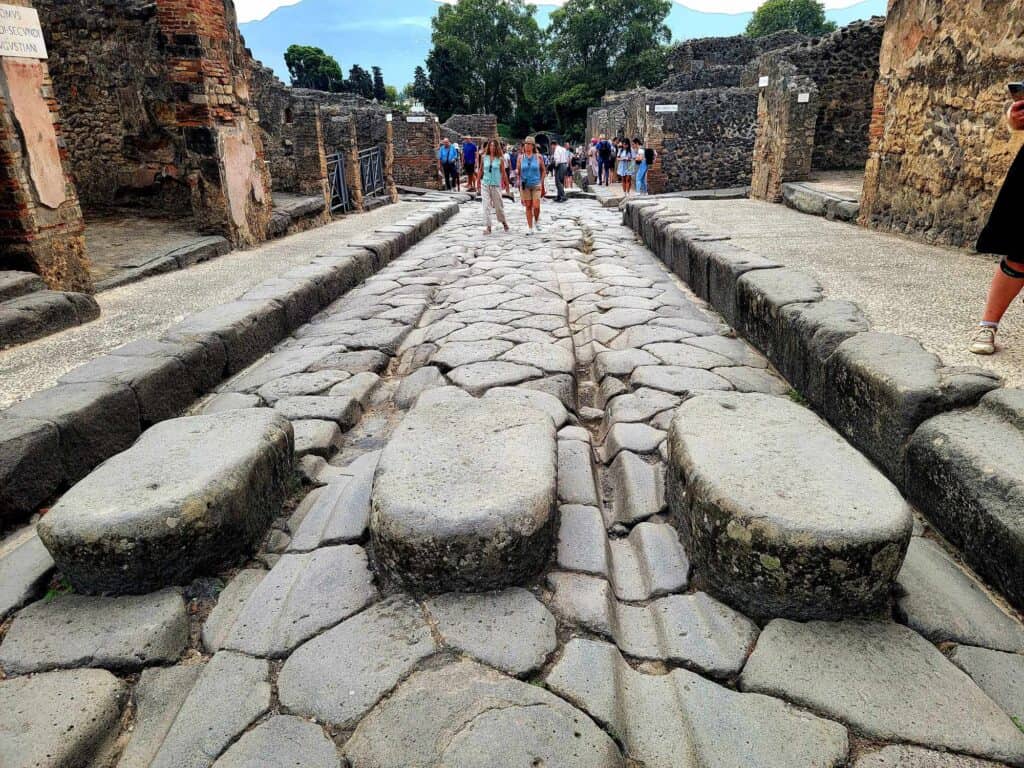
- Vast and rugged. Expect:
- Uneven cobblestones.
- Raised sidewalks with stepping stones between them, and grooves for chariots
- No handrails on steps.
- I rolled my ankle more than once because I was gawking at something amazing and not paying attention to where I was walking!
- A few accessible areas have been added, but it’s still a little challenging.
- 10,000+ steps is typical for even a partial visit. If you spend all day, count on 20k+
🏠 Herculaneum:
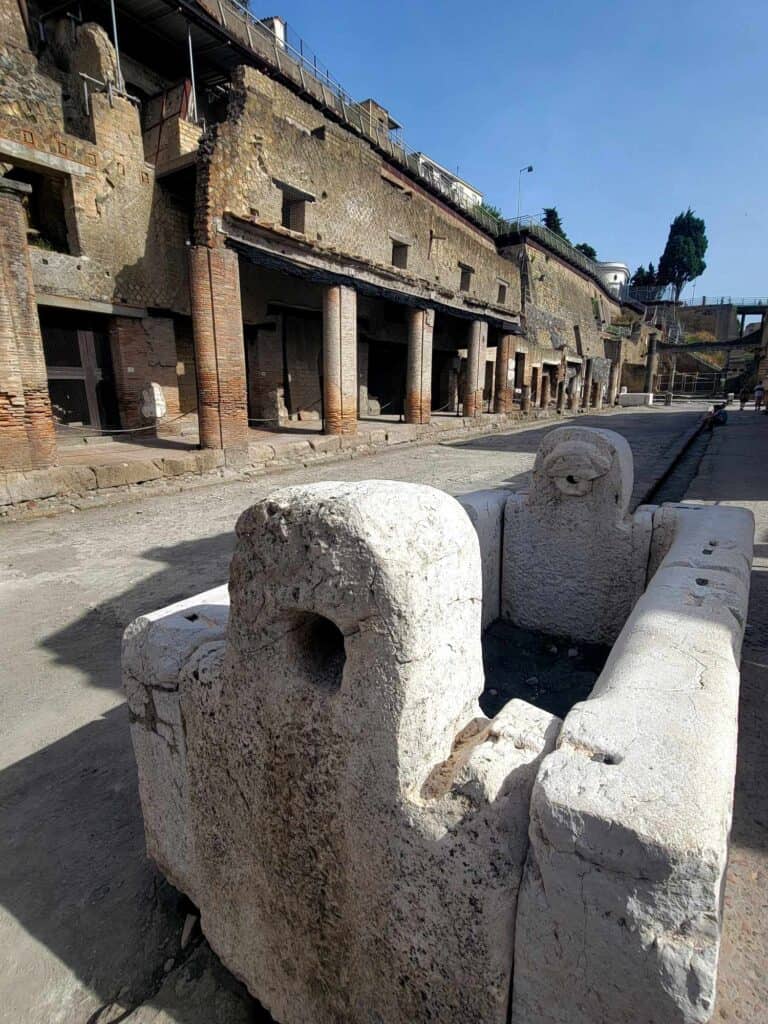
- Much smaller, and walkways are flatter and easier to navigate.
- Wooden ramps and modern walkways in some areas.
- Much shorter walking distances. To see all of it, count on 6000+ steps
💡 Pro Tip:
If you or someone in your group has mobility concerns, Herculaneum is far more manageable. Pompeii can be physically demanding for anyone, especially if it’s hot.
👀 What You’ll See: Layout, Highlights & Vibes
Pompeii and Herculaneum offer two very different types of immersion, and neither is better, just different!
🌆 Pompeii: Big City Energy
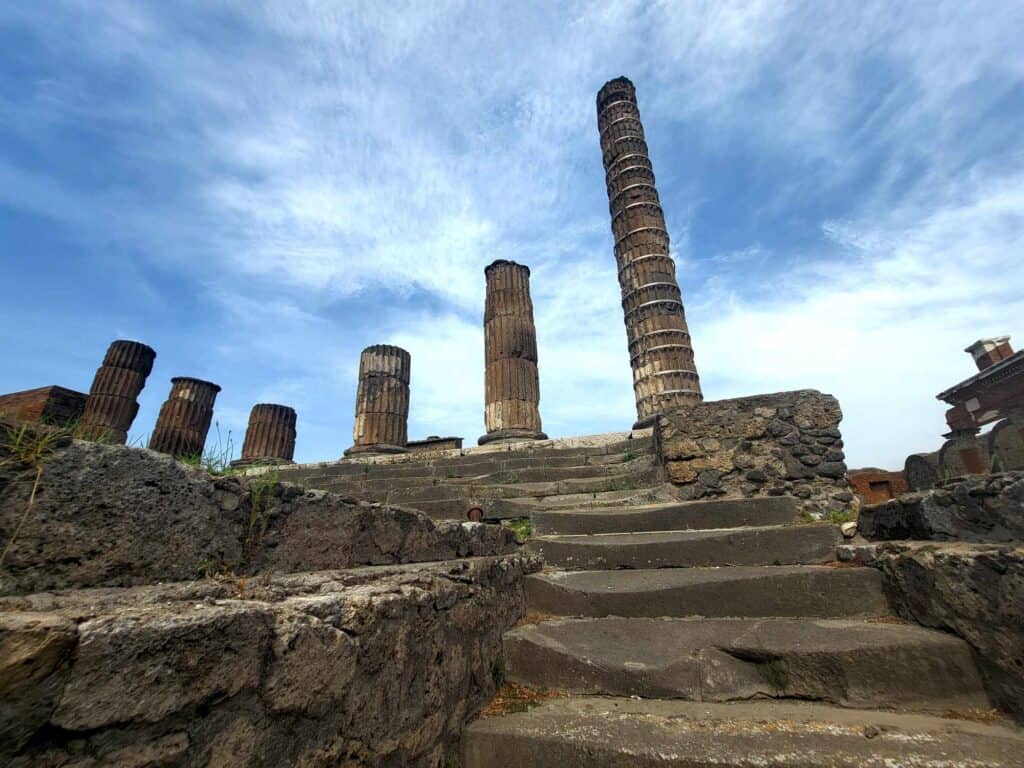
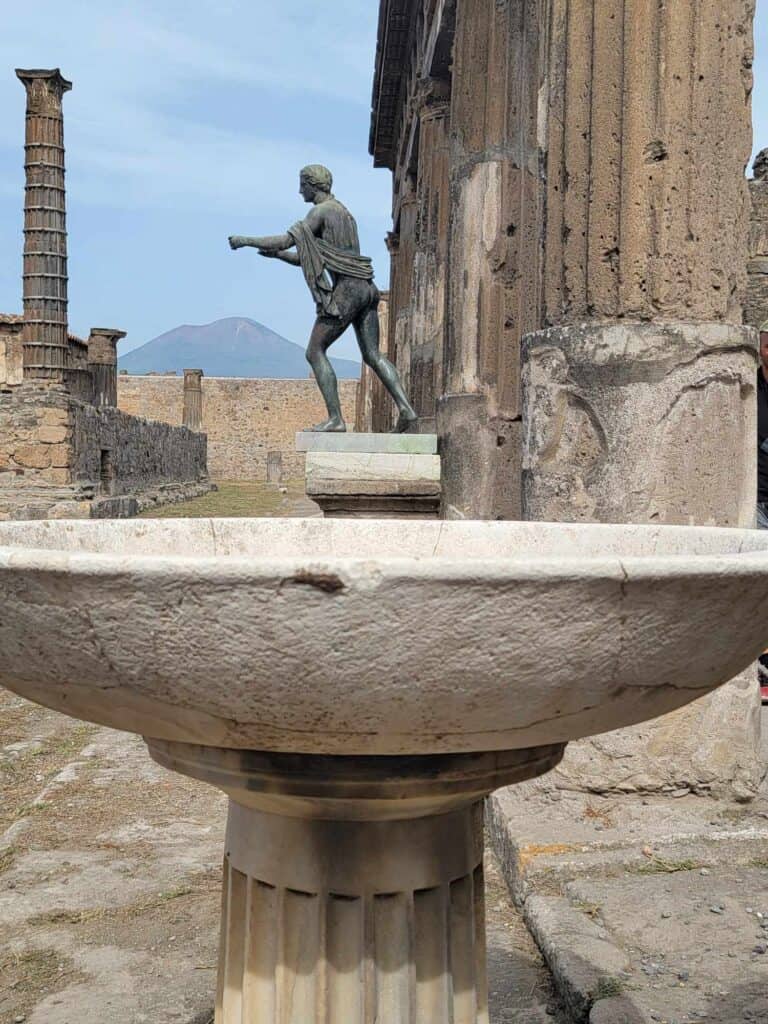
- Think of Pompeii as a bustling Roman city. 20,000 people once lived there!
- You’ll see:
- The Forum & excavated temples of Apollo and Juno
- A huge, amazingly well-preserved amphitheater that you can explore
- Gladiator barracks
- Ancient carved graffiti
- Lupanar (brothel) with frisky frescoes
- House of the Faun (home to the famous Alexander the Great mosaic)
- Streets of shops, bakeries, restaurants, humble dwellings, and villas
- Feels grand and monumental.
🏘️ Herculaneum: A Wealthy Seaside Town
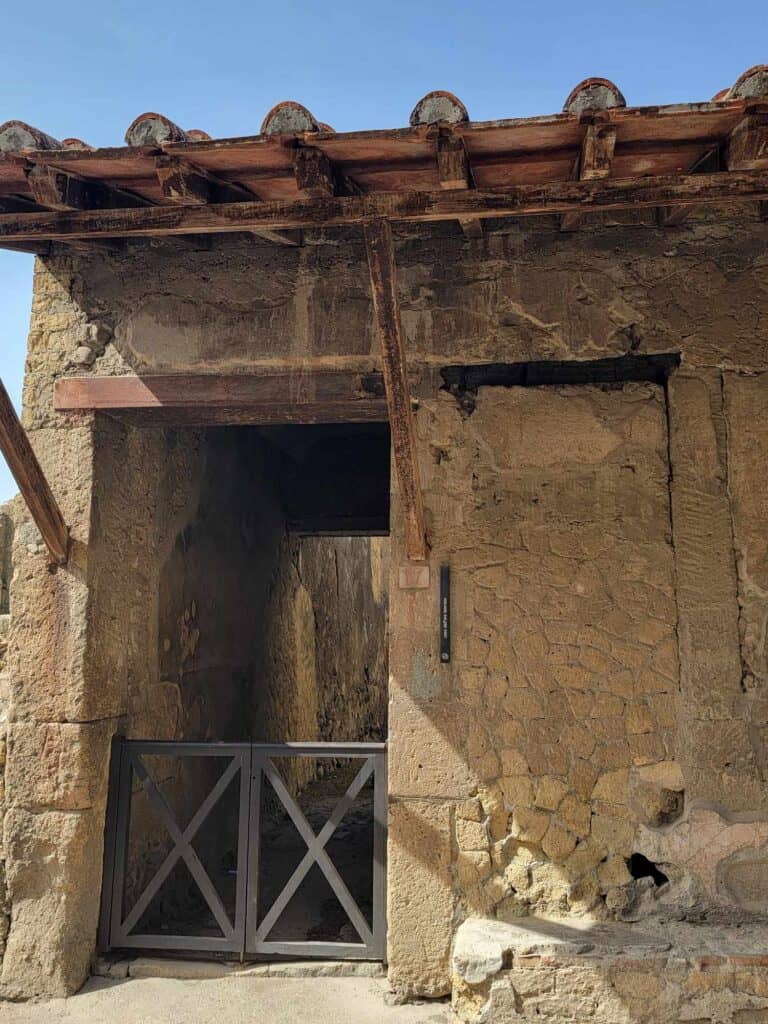
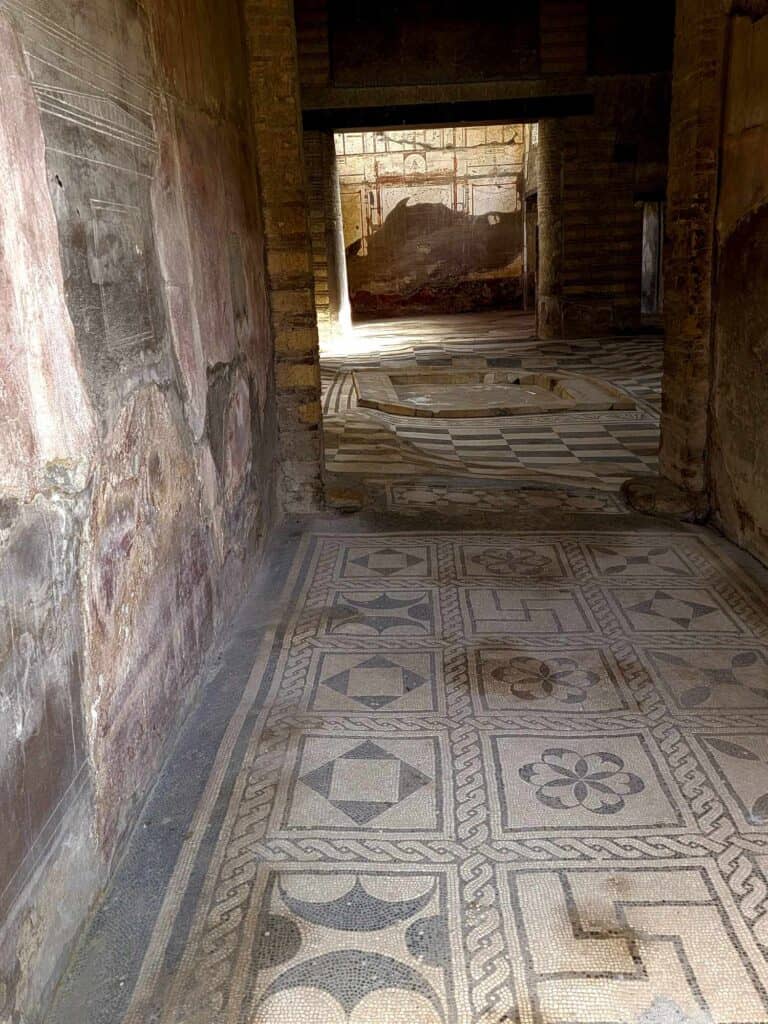
- Herculaneum is a smaller, sleepier seaside town with greater preservation.
- You’ll see:
- The Augusteum
- Wooden furniture, second stories on the buildings
- Incredible thermal bath house with frescoed walls and mosaic floors
- Carbonized wood details everywhere
- Boathouses (where 300+ skeletons were found)
- Ancient beachfront and docks
- My favorite little restaurant with incredible marble inlays in the countertops
- Feels more immersive and intimate.
💡 Pro Tip:
Pompeii gives you scale. Herculaneum gives you detail. If you want big impressive buildings, go for Pompeii. If you want better preservation and incredible detail, Herculaneum is for you.
💀 The Victims of Pompeii vs. Herculaneum: Casts vs. Skeletons
Both sites are profoundly emotional, but the way the human devastation was preserved is very different.
Pompeii: Plaster Casts of Voids
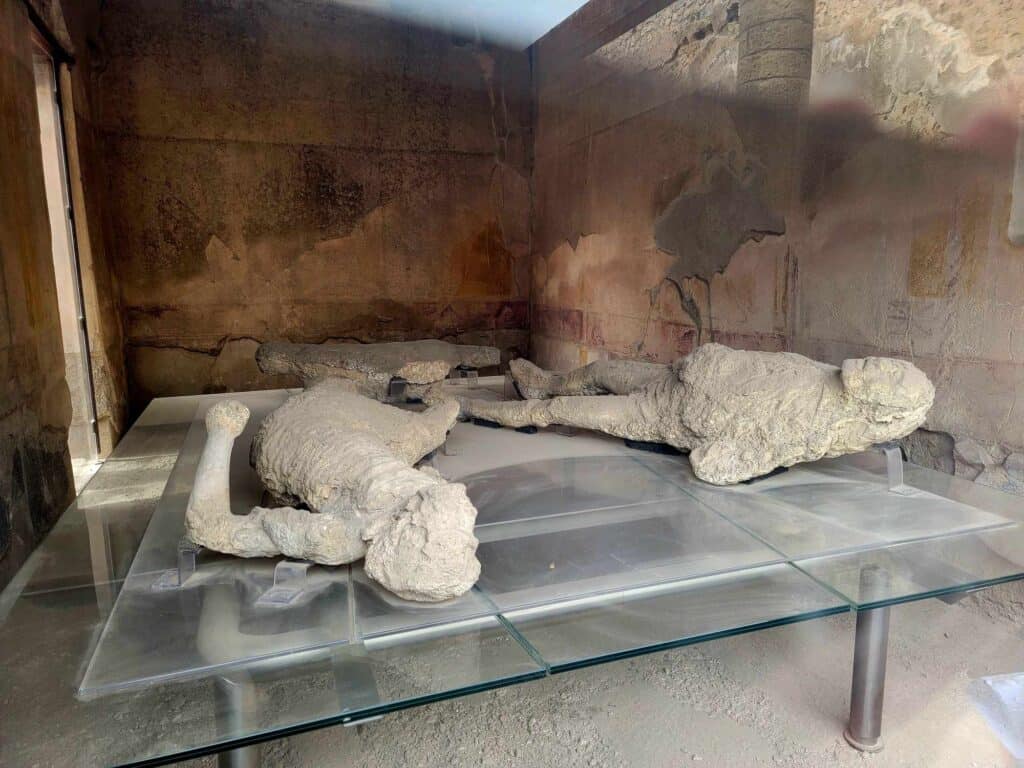
- Over 1,000 victims have been found in Pompeii. The bodies of those who died were encased in falling ash. When the bodies decomposed they left voids in the ash.
- In the 1800s, archaeologists poured plaster into these voids, creating life-like casts of the victims in their last moments – some lying together, or curled up, protecting one another. There is even a dog.
- The vast majority of these plaster casts are housed at the Naples Archaeological Museum, but you can see a couple on site like the two women above who remain in the house where they were found.
Herculaneum: Real Skeletons by the Shore
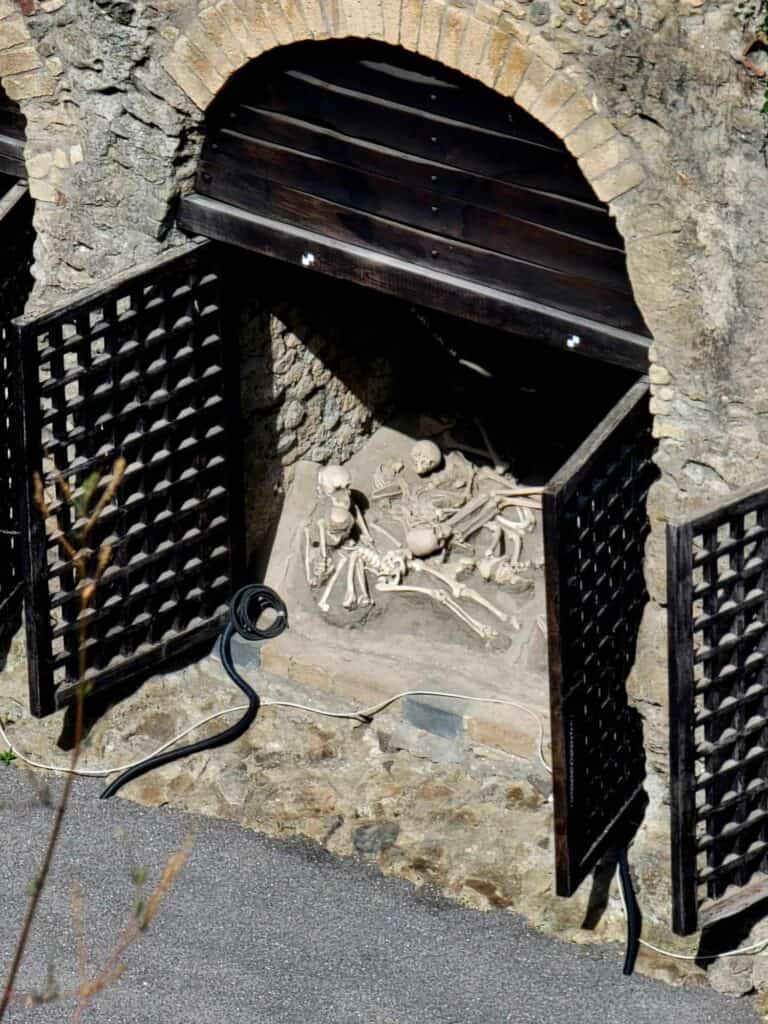
- For decades, no victims were found in Herculaneum and it was assumed everyone had managed to escape.
- Then in the 1980s archaeologists uncovered over 300 skeletons huddled in the boathouses by the ancient shore, likely waiting for a rescue that never came.
- Some of the skeletons were found with preserved jewelry, clothing, or personal items.
- The actual skeletons are not on site, but reproductions of the skeletons are in the boathouses so you can see and feel what it must have been like to make that discovery.
🏛️ Museums: Naples & Herculaneum
To really appreciate either site, you need to see what’s missing, because most of the treasures are of course no longer on-site. In Pompeii they’ve done a nice job placing some excellent reproductions of art objects where they were found so you can see what they looked like – like the mosaic of Alexander the Great, and the bronze statue of the faun. But the originals are kept in Naples at the museum where they can best be preserved for the ages.
🎨 Naples National Archaeological Museum (Museo Archeologico Nazionale)
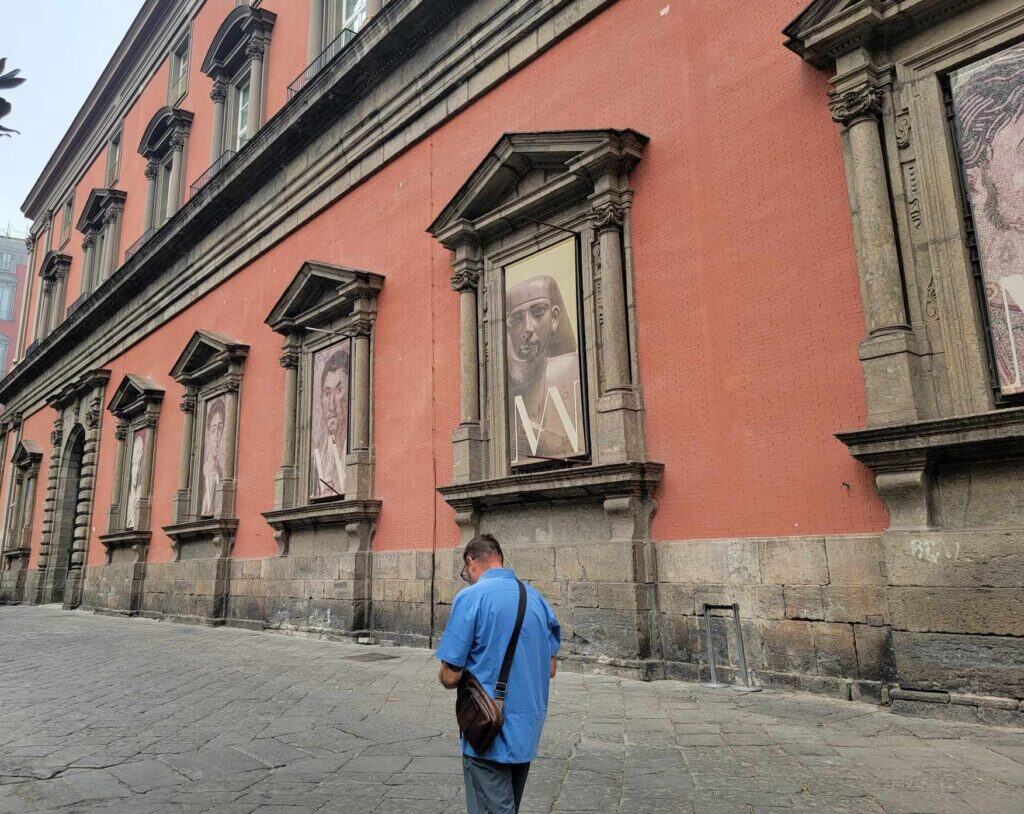

What you’ll see:
- Home to the best mosaics, frescoes, statues, and artifacts from both Pompeii and Herculaneum!
- Must-sees:
- The Alexander Mosaic (from Pompeii’s House of the Faun)
- Erotic art from the “Secret Cabinet”
- Beautiful bronzes from Herculaneum’s Villa of the Papyri
- If you’re only visiting one museum in Naples — make it this one.
🏺 Herculaneum’s Onsite Museum (Antiquarium)
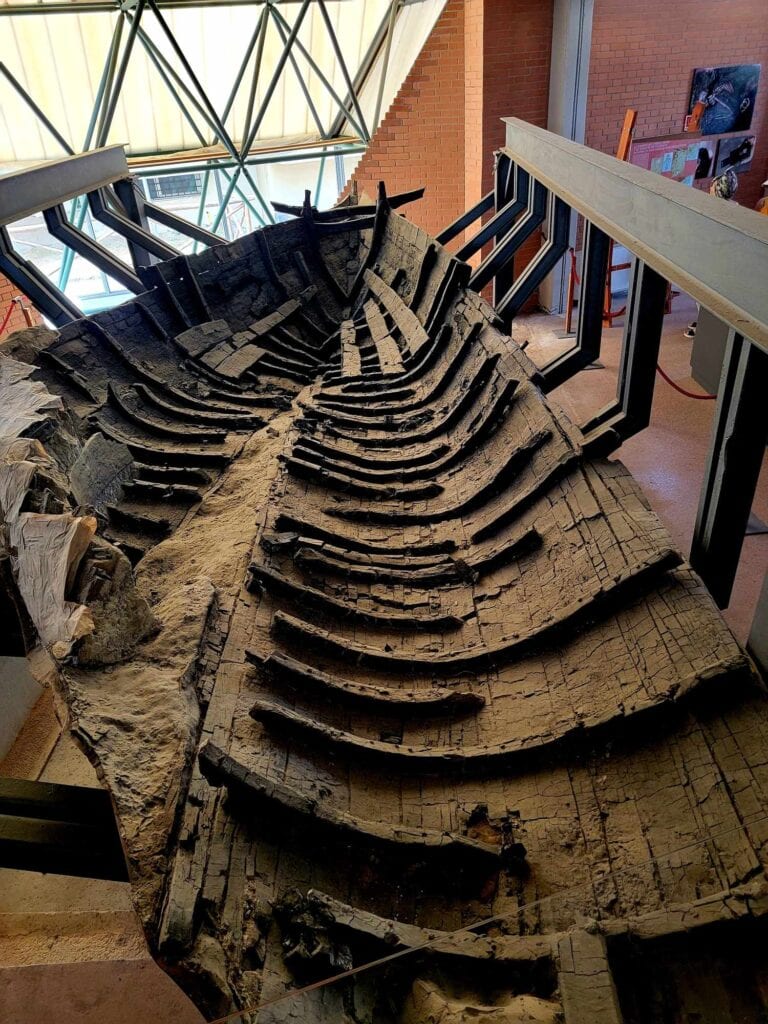
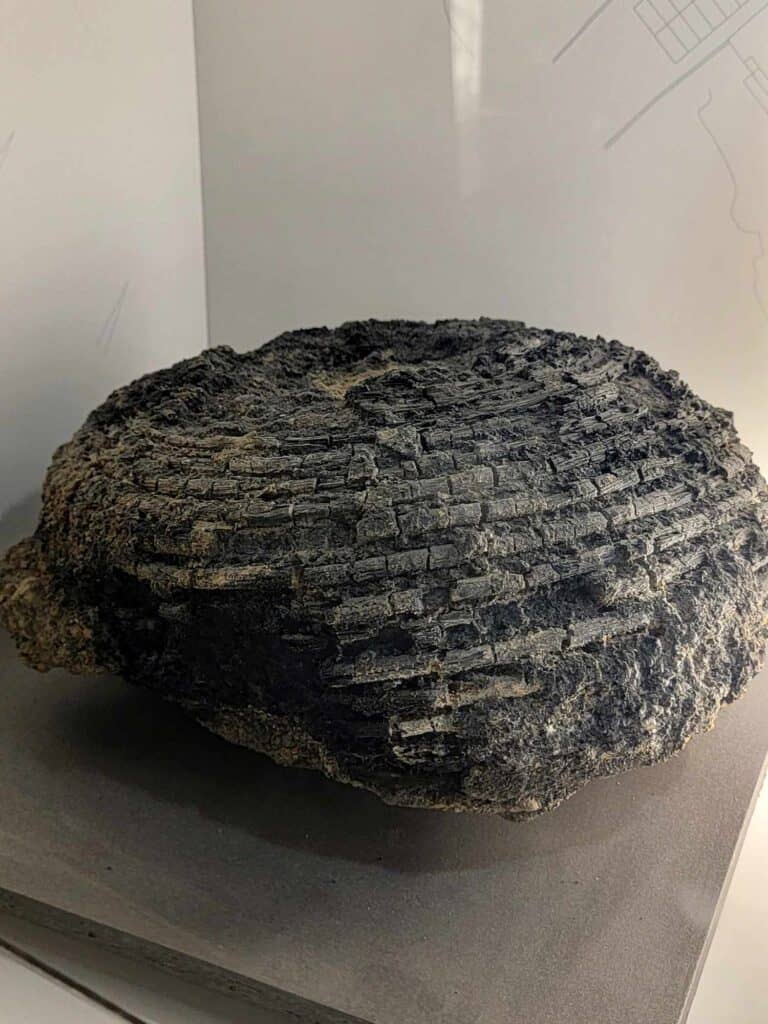
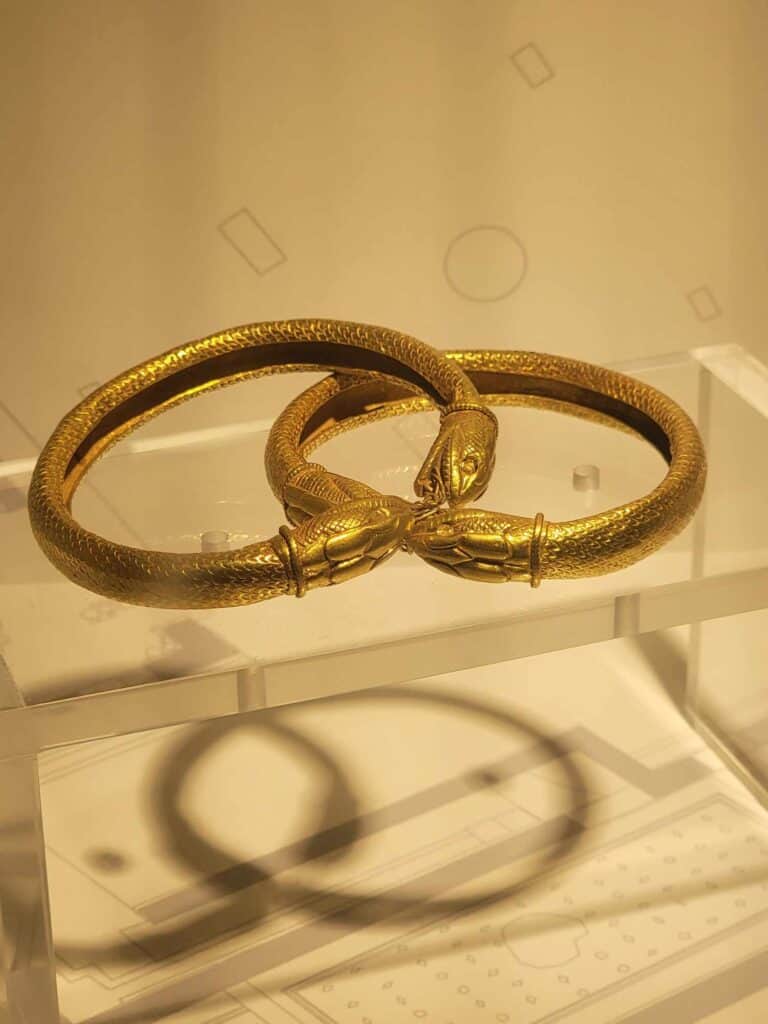
What you’ll find:
- Small but very well-curated.
- Displays of personal objects, wooden artifacts, sculpture, jewelry, and carbonized furniture.
- There are whole boats, and rope that were carbonized and preserved
- Recently renovated and worth a stop after your site visit.
- If you are not going to the museum in Naples, this is an absolute must-see as it will be your only chance to see some of the objects discovered in these incredible places
💡 Pro Tip:
You can visit the Naples museum before or after seeing the ruins, but try not to skip it if you want the full picture.
⚖️ Final Comparison: Pompeii vs. Herculaneum — Which Should You Visit?
Yep, you even get a chart to help you make that final decision! And remember, if your time allows, definitely see both plus the Naples Archaeological Museum for the full-on experience!
| Factor | Pompeii | Herculaneum |
|---|---|---|
| Size | Huge (takes 4–6 hours or more) | Compact (2 hours or less) |
| Shade | Almost none | Moderate |
| Walking | Challenging, lots of steps | Easier terrain |
| Highlights | Amphitheater, forum, brothel, mosaics, temples | Second stories, wood, skeletons, museum, bath house |
| Atmosphere | Grand, open, dramatic | Intimate, immersive, personal |
| Preservation | Stone and mosaics | Organic materials, and stone |
| Victims | Plaster casts | Skeletons |
| Best for… | First-time visitors, history lovers, iconic sites, lots of time, good mobility | Detail-oriented travelers, summer visits, limited time, mobility issues, heat intolerance |
Opening Hours for Pompeii and Herculaneum
Last admission times, and closing times for both sites vary throughout the year, but Herculaneum opens at 8:30am and Pompeii opens at 9:00am.
Check the official website of each site to be sure of timing and holiday closures when you plan your visits:
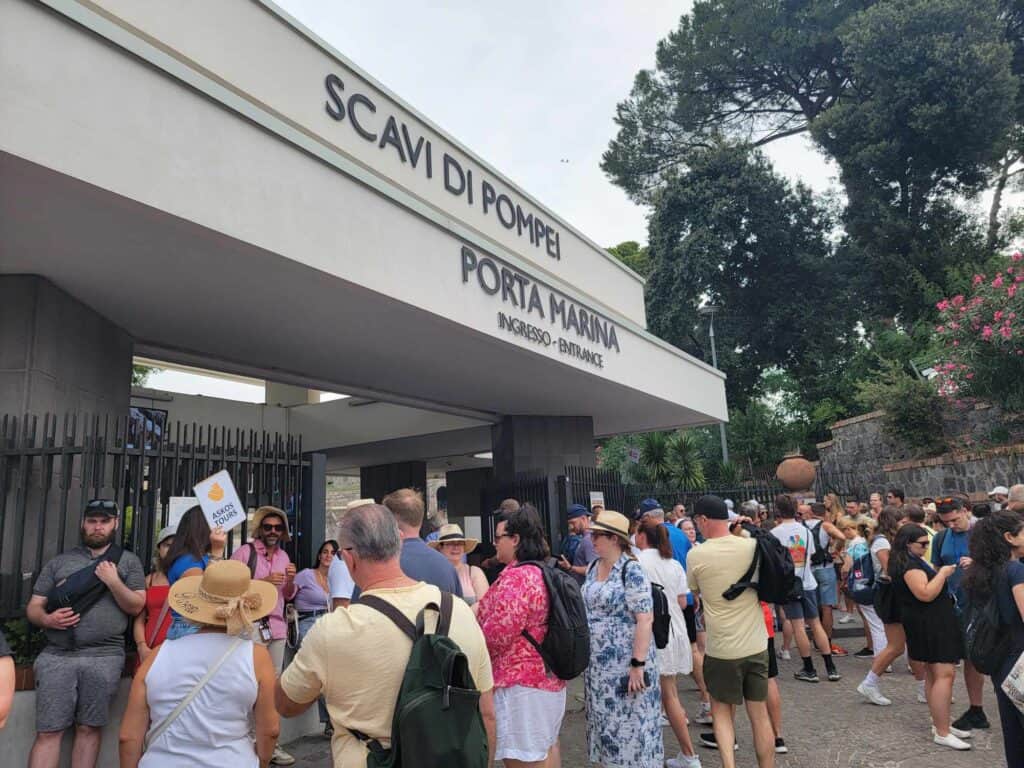
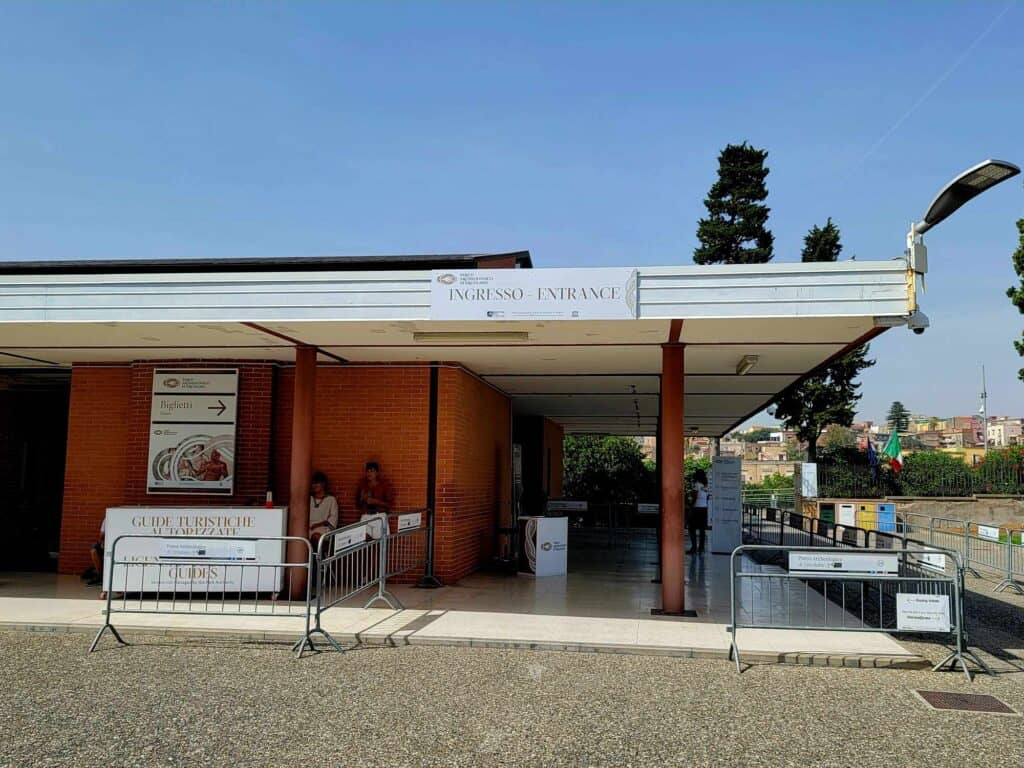
🤩 My Ideal Itinerary as an Archaeology Nerd
If you are a 10/10 archaeology or history nerd, and you have more than one day to dedicate to this once-in-a-lifetime area, here’s exactly what I’d do!
Day 1 – Pompeii all Day!
Get a guided tour of Pompeii first thing in the morning. No tour can cover everything, so after your tour ends, you can stay as long as you want and go back to find the places you wanted to see that weren’t covered in the tour.
If you need a lunch break, head to the Hortus restaurant which is right outside the gate. Have a pizza and a cold drink, and head back into the park to finish up.
Highly-Rated Tours of Pompeii
Day 2 – Herculaneum and the Archaeological Museum in Naples
Get a guided tour of Herculaneum first thing in the morning. Same drill. When the tour ends you can go back and see whatever you like. You’ll spend much less time doing that here than in Pompeii since the site is so much smaller.
Highly-Rated Tours of Herculaneum
Then take a quick tour through the museum at Herculaneum to whet your appetite for what is to come!
After you are finished, head to the Archaeological Museum in Naples and grab a quick bite in the museum’s MANNcaffè if you’re hungry. Spend the afternoon blissfully immersed in the treasures of Pompeii and Herculaneum. There are two whole floors dedicated to these treasures!
After your museum visit, head across the street to the charming Tesoraria for a cocktail and a bite.
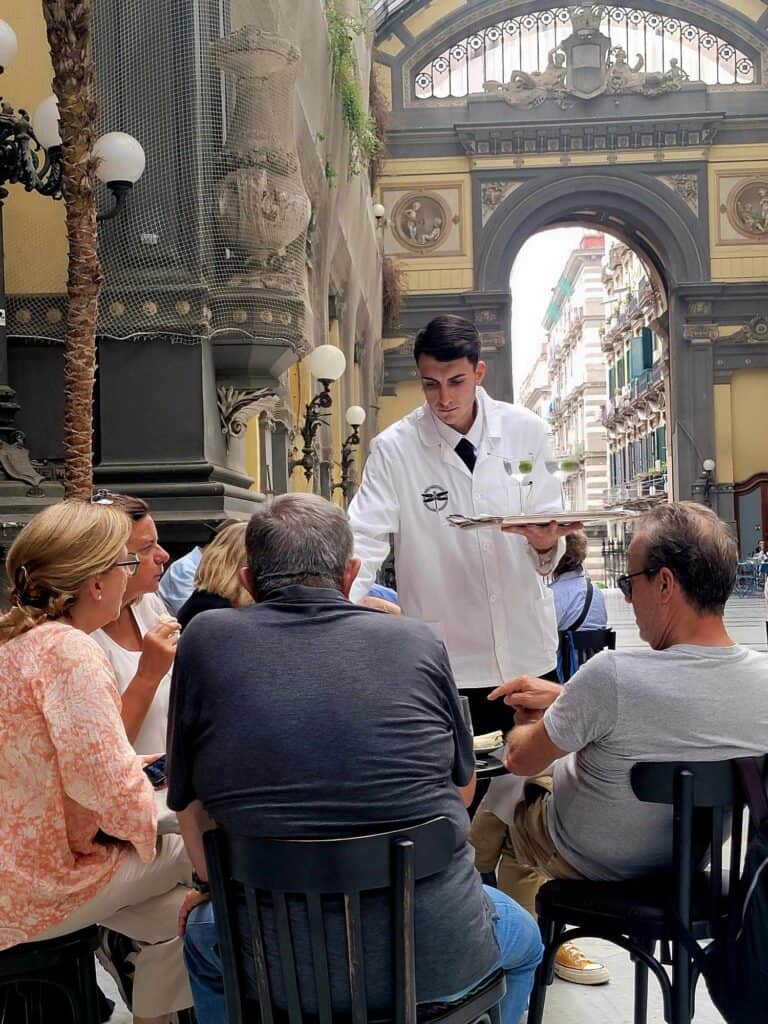
Additionally, directly across from the museum is the Caffetteria Principe di Napoli, located within the Galleria Principe di Napoli. This café offers an array of gastronomic delights and is known for its active presence on social media platforms like TikTok and Instagram.
🏃♀️Itinerary for Pompeii and Herculaneum in One Day

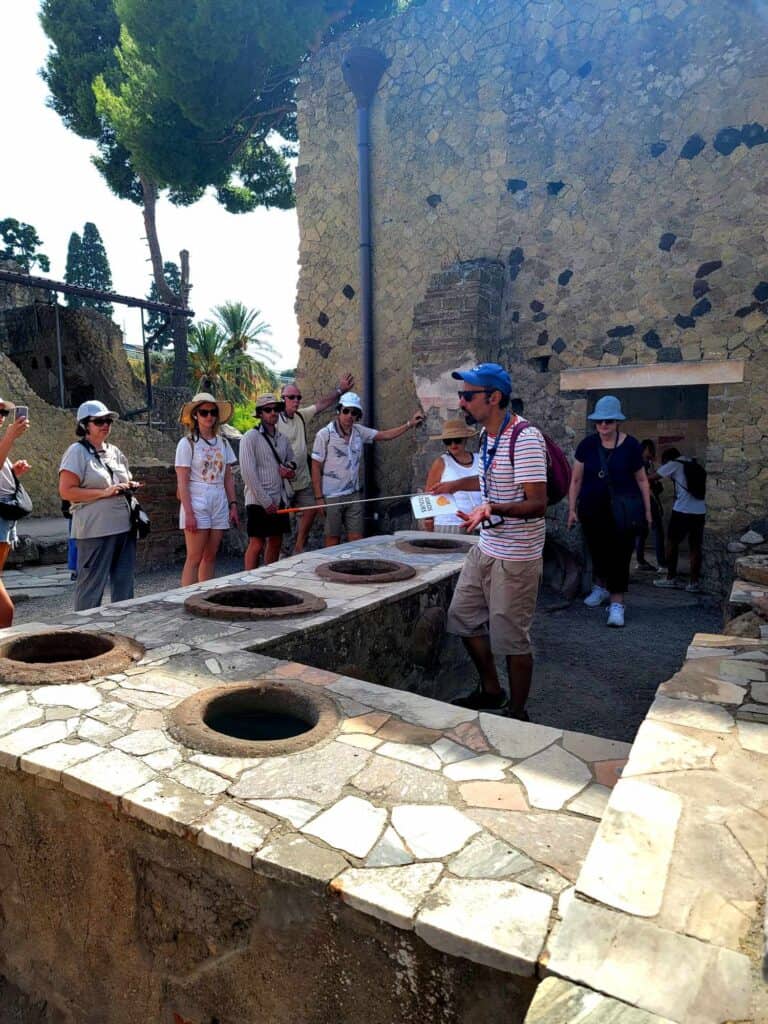
If you have limited time but really want to see both sites, your plan should include a guided tour. As long as you realize that you will have to skip out on some of the things in Pompeii, and that you will be on the move all day, you can have a fabulous time and see a LOT.
✅ I highly recommend this tour to see both Pompeii and Herculaneum in one day.
Our guide was an archaeologist who was very knowledgeable and enthusiastic about both sites. He did a really great job of covering a lot of ground in a limited time.
We saw all the big sites in Pompeii – the forum, the amphitheater, the temples – and got to see several famous villas and hear their stories.
We also got a very comprehensive tour of Herculaneum and saw pretty much the whole site. The stories of gladiators, the attempted escape to the boat houses, and the scientific marvel of the preserved wooden furniture had me absolutely spellbound.
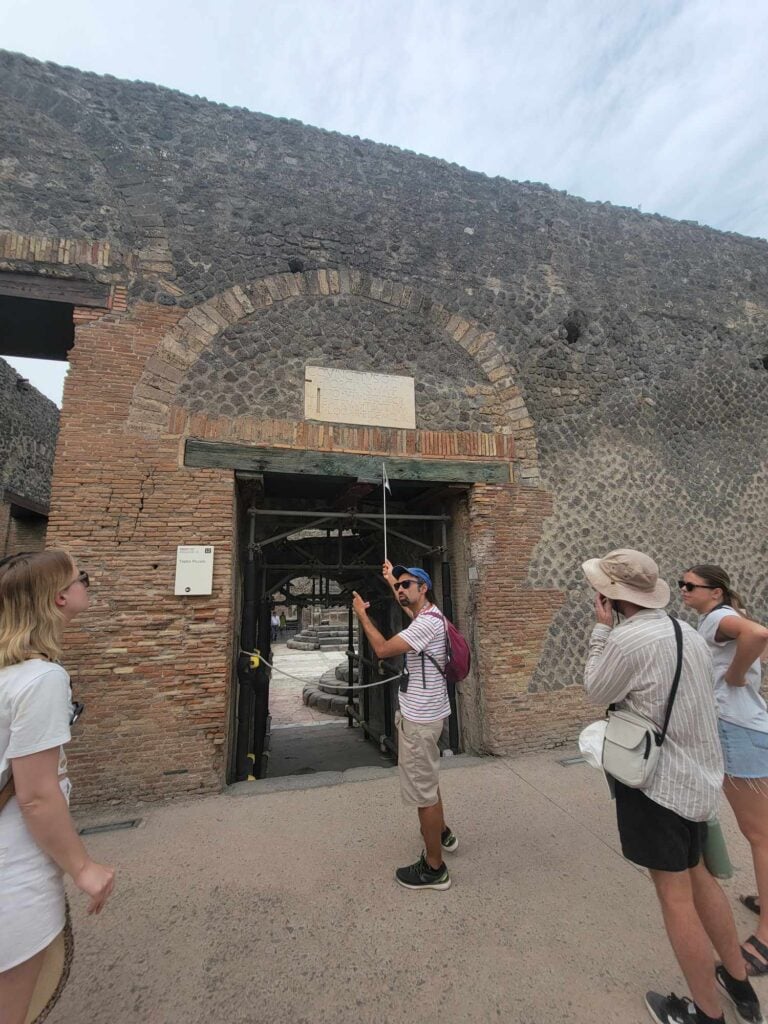
By the end of the day I was hot, exhausted, and completely happy. It was absolutely one of my favorite tours of all time!
So if you are dead set on doing it all in one day, this is the way to go!
✨ Bonus Tips

I teased my husband about his vest filled with water bottles, but I owed him a big apology because we were both really happy to have them!
🥵 Wear light, breathable clothing
👟 Wear comfortable and supportive walking shoes
🕶 Bring sunglasses, and a sun hat
🌞 Use a good high SPF sunscreen
💦 If you are coming in the summer, consider getting a misting fan to help keep cool and avoid heat sickness. They really do help!
💧 Bring twice as much water as you think you will need
🔋 Bring a battery pack for your phone because you will be taking LOTS of pictures!
🏛 Combine your trip with other nearby sights (e.g., Mount Vesuvius, Archaeological Museum in Naples)
🫒 Don’t ever eat a fresh-picked olive off a tree. (Yes, I did this in Herculaneum. Yes, I regretted it immediately!)
Enjoy Your Trip to Pompeii and/or Herculaneum!
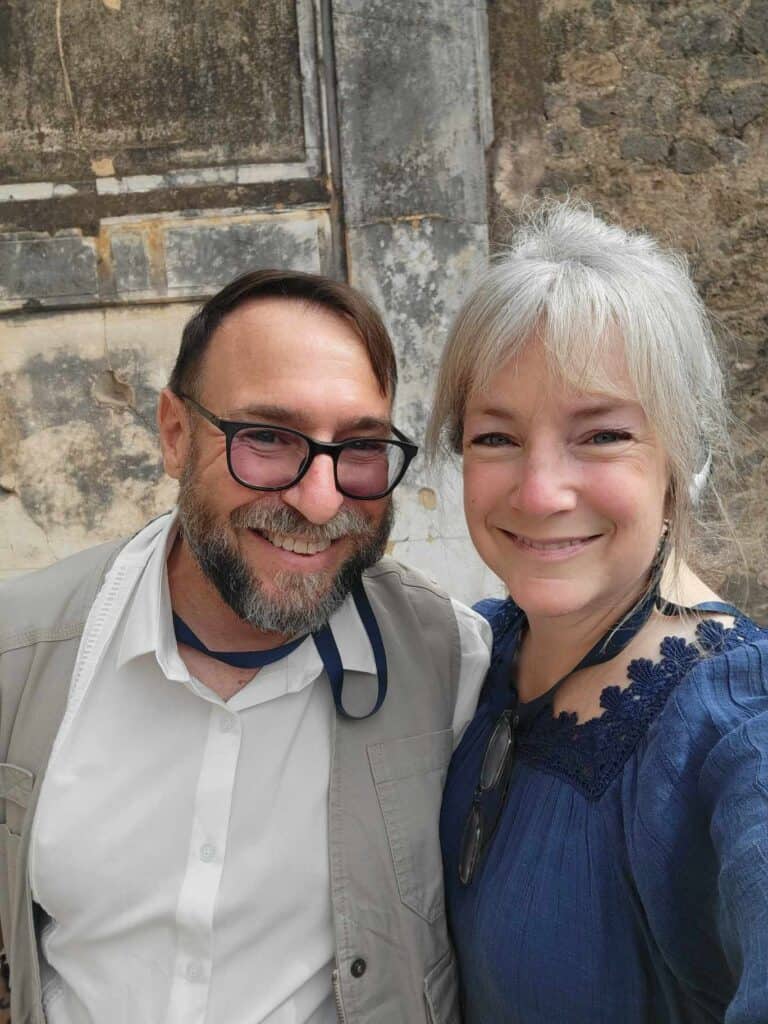
I hope I’ve helped to answer the sometimes confusing Pompeii vs. Herculaneum question for you! The good news is that there is no wrong answer. Whichever site you visit, or if you’re lucky enough to visit both, you will have an absolutely epic time.
Nowhere else in the world can you truly feel like you’ve stepped back into a living breathing ancient past in this way!
You Might Also Enjoy These Posts:
- Epic 16-Day Italy Road Trip With Your Dog
- The 7 Most Amazing Things to Do in Ravello Italy
- Ostuni the White City is Your Gateway to Puglia
- Villa Cimbrone Gardens in Ravello – Heaven on Earth
- Why Matera, the Oldest City in Italy, Blew My Mind
- Ravenna, Italy – Ultimate One-Day Itinerary!
- Is Pisa Worth Visiting?
- Staying at Magnificent Hotel Miramare Stabia with Your Dog – a Review
- Spectacular Hotel Villa Amore Ravello – a Dog-Friendly Hotel Review
